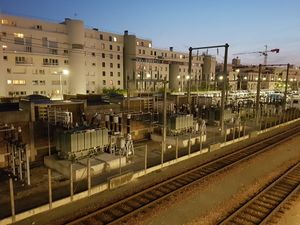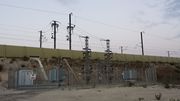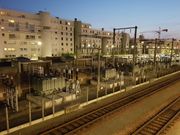Proposal:Traction substations extension

| Traction substations proposal | |
|---|---|
| Proposal status: | Proposed (under way) |
| Proposed by: | fanfouer |
| Tagging: | frequency_conversion=*
|
| Applies to: | |
| Definition: | A new key to give better description of frequency conversion processes in traction substations |
| Statistics: |
|
| Draft started: | 2019-04-05 |
| RFC start: | 2019-04-25 |
Proposal
It is proposed to add a key frequency_conversion=* on traction and converter substations to state if any conversion process with frequency change is running inside.
Expected values would be yes, ac_dc, ac_ac or no.
The last is intended to say no converter should be found inside the substation and the frequency isn't changed. It solves the indetermination problem of missing features on the map : does they exists and should I look for them or they don't exist at all?
Some traction systems may be found with multi-phase systems, sometimes different from number of connected phases from public grid side (3 phases on the public grid to 2 phases on the traction interface for instance). This is a device and lines property inside the substation and this proposal doesn't regard this aspect of things. frequency_conversion=* should be used without any concern about alternative phases (466-01-04) or direct current poles (466-01-06).
No value will be deprecated or replaced and substation=traction remains the usual value to describe train power supply substations.
Proposed frequency_conversion=* won't be compatible with power=converter features as it's better to use frequency:primary=*, frequency:secondary=* like voltage:primary=* on power=transformer. It's out of the scope of this proposal.
Rationale
Electric railway traction feeding substations are currently described in OSM with substation=traction. Users will know consumed power is dedicated to trains running on railways next to those substations.
There are numerous possibilities to transform and convert power to make it suitable for trains, with alternative or direct current at many voltages.
Nevertheless, it's not easy to know if the substation involves a frequency conversion process or not if internal equipments are hidden inside a building for instance. We'll see that frequency=* is a device property and is not suitable to be propagated on the substation feature. Then additional tags can state that a particular process is running in the substation and we can expect to find a particular kind of device inside (useful for QA tests). Traction substations not always convert power since modern systems now run with alternative power.
Most of substations are described with voltage=* or frequency=* in OSM but those keys should be carefully handled. It is currently recommended to mention the highest voltage (or the most common frequency) in the substation at least, then a single voltage or frequency value can independently mean there is no transformer or there are lower voltage running there. This must be said voltage=* is comfort tagging for render as it eases the colour choice based on the presumed substation size upon its highest voltage.
As any other aggregated value (like frequency=*, phases=*...) coming from hosted features in the substation, voltage=* or frequency=* should be an internal feature property only and this is out of the scope of this proposal. voltage=* nor frequency=* aren't used as reliable information for substations here.
It's not possible to use substation=converter as this key is already took for traction, then another key is required to state this particular function.
Conversion of frequency
Conversion (601-01-07) refers to the change of frequency of voltage (or current) of the power transiting in a network. This is done with the help of power=converter. See AC / DC conversion on transmission network for instance.
Traction substations often involves AC/DC or AC/AC - public grid to a different frequency (50Hz to 16.7Hz in Germany/Switzerland for example) - conversion but not always. Modern trains can now run with alternative power coming directly from transmission or distribution grids. It would be useful to add a key on the substation features to explicitly state that power=converter devices are expected or not.
Mappers will be able to define it simply by comparing which frequency they got at home (for the public grid side) and the frequency used on the railway power systems. Railway power systems are well documented with public data or public knowledge.
If no data is available and knowledge isn't shared, then don't map it.
Deduction from voltage may not be accurate
You may think people will be able to deduce if actual conversion is running inside a substation just by looking at voltages, especially the railway ones.
There are no ranges dedicated to alternative nor direct currents.
- AC systems run between 750 V (or lower) and 25 kV
- DC systems run between 750 V (or lower) and 3 kV
Modern AC traction systems run with medium voltage like 25 kV whereas DC systems (both old and recent) use to run on low voltages like 3 kV or 750 V (among other possibilities, mainly for local transports).
Railways may be found running with actually low voltages between 750 V AC and 1 kV AC. See Gornergrat_Railway or Jungfrau_Railway for such examples.
Then looking at voltage to deduce the frequency and extensively the conversion running in a given substation won't be accurate at all.
Then we'll need some keys to prevent any false deduction from voltage.
Concrete benefits
- Ability to indicate which kind of conversion (or not) is running in
tractionorconvertersubstations withfrequency_conversion=*. Currently it's not possible whereas trains systems not always run with DC power. - Improve QA tests relevancy by analysing if according
power=converterfeatures are found or not in the substation and encourage mappers to look for explicitly missing ones.
Tagging
Following the rationale, proposed frequency_conversion=* would be used with according values :
| Key | Value | Comment |
|---|---|---|
frequency_conversion=*
|
yes | A conversion occurs here, without any more knowledge |
| ac_dc | A conversion from AC power (provided from the 50/60Hz public grid) to DC power for trains. | |
| ac_ac | A conversion from AC power provided from the 50/60Hz public grid to different frequency (still AC) for trains | |
| no | No conversion is running inside the given substation and no power=converter should be found inside.
|
How to find which kind of conversion is operated?
You have to gather 2 independent data:
- If the substation is fed by public network, the frequency at which the last operates. Wikipedia got a list of standards by country.
- Voltage and frequency required by trains using any electrified railway connected to the substation you are mapping.
frequency_conversion=* value depends on those two pieces of information. A substation feeding trains with DC current (frequency=0) from AC 50Hz power grid (frequency=50) will get frequency_conversion=ac_dc for instance.
Edition management
No keys are planed to be replaced with the current proposal.
On 5th April 2019, 3 449 substation=traction are described in the database and may receive the proposed frequency_conversion=* key.
Affected pages
- Update the
substation=tractionpage. - Create the
frequency_conversion=*page.
Examples
| Photo | Location | Tagging | Note |
|---|---|---|---|

|
France |
|
25kV traction substation with 2 auto-transformers. No power lines feed this substation except the contact line 25kV feeder going along train tracks. |

|
Germany |
|
Traction substation with two 26.5 MW Motor–generator-sets. Power is taken from the 110 kV 50 Hz 3-phase-grid and converted to 110 kV 16,7 Hz single-phase current, which is transmitted to other substation, but also transformed to 15 kV power to be fed in the overhead lines. Energy flow can be from the national grid to the railway grid or vice-versa. |

|
France |
|
A traction substation in Paris designed with 3 63kV AC outdoor transformers and with DC converters inside the building (we don't know how many of them). The railway runs with 1500 Volts DC. |